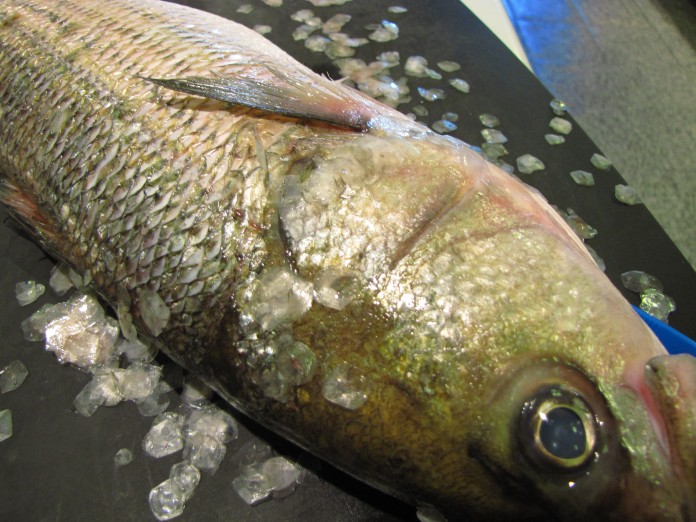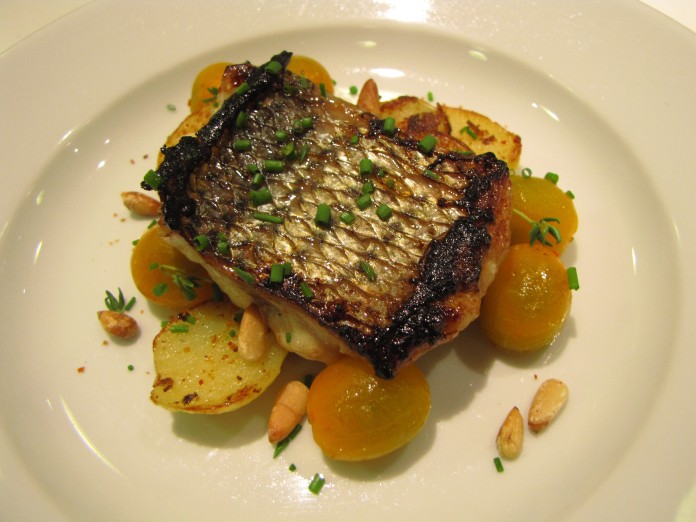During the last few years, restaurant menus have come to feature more and more of the offal – those off-cuts that so often get thrown out or turned into pet food out of ignorance of their savory qualities. I’ve written about offal around here from time to time – using liver for pâté and terrines, the joys of sweetbreads, cheeks and caul, for a start. We eat those, and plenty more – the tongue and heart, and brains are favorites.
In all the talk and excitement about oxtail and beef tongue, pork liver and lamb brains, fish often gets left behind. And that’s a shame, because – unlike most eating mammals – fish are small enough that a home cook can break down the whole animal and consume it within a meal or two. What kind of offal does the fish have to offer? Well, if you’re like most people, you’ve been eating fish primarly in fillet form, or maybe once in a while cut into steaks. Every fish has a collar, though – basically the neck – which holds delicious bits of meat; larger fish often have very moist, scallop-like cheeks; and then there’s the liver. In the spring, you’re apt to find roe sacs; for some fish, like pike and shad, these are quite creamy and delicate, even more tender than brains. Shad is reliably delicious, which accounts for its recurring star turn every spring; the rockfish roe (pictured below) is tender and moist, but sometimes can have a bitter, bleachy taste that is off-putting.
If you’re new to fish off-cuts, the collar is probably the friendliest for a start. The recipe below for rockfish collar will be familiar to you if you’ve ever ordered hamachi kama, or the yellowtail collar, at a Japanese restaurant. If you don’t want to deal with off-cuts, try the recipe for a seared rockfish fillet, which pairs yuzu with tomato in a delicious sauce.
Rockfish collar, togarishi goma
The collar of any fish holds some of its sweetest meat – within the c-shaped curve of the bone are moist nuggets of fish, akin to the crab backfin meat in terms of flavor and succulence. Each fish only has one, of course, and it isn’t considered a prime cut, so you’re not going to find it unless a) you break down your own fish (which I recommend of course, to keep your knife skills tight and to get the freshest product); b) you live in a city with a large Asian population and a great fish market; or c) you have a reliable fishmonger who breaks down fish in-house and can sell or give you the collars. It’s worth asking around if you’re not willing to break down your own fish.
If you do want to try your hand at butchery, you’ll find it’s not hard. I recommend you have someone scale your fish, at a minimum (I sometimes do it myself but it is a colossal mess); if you have no plans for the liver and roe, they might as well gut the fish too, because the air bladders can be difficult to separate from the gills. Just ask to have your fish scaled and cleaned.
Lay the cleaned fish on one side with the head to the left and the belly facing you, on a couple of clean kitchen towels on a cutting board to reduce slippage. Start by trimming off the fins, which can be poke-y. Slice the fish downward through to the bone, about an inch behind the gills (if you took economics, you’re looking at a slightly downward-sloping demand curve). Then, starting at the tail end, slice off the fillet, working along the central bone at a slight angle so the blade runs against the bone, with your other hand holding the fish in place, ending when you reach the gill incision. Flip it over and do the other fillet. At this point you can clean the bones from the fillet, trim off the belly fat, etc.
To get to the collar, first chop off the spine at the incision you made behind the gills. The portion of the head between the gills and that incision is the collar – and it usually contains the fish’s pectoral fins. Think of the collar as the neck, more or less. You can cut the cheeks out of the head as well – sadly, with the typical 18-20″ rockfish, the cheeks are pretty small. Use the spine and the rest of the head for fish fumet (akin to stock); you’ll simmer it with onion, celery, carrot, fennel, white wine, and aromatics for about an hour and strain through a cheesecloth-lined chinois.
The recipe below specifies togarishi goma, which, broken into its Japanese components, refers to a spicy seasoning of shichimi togarishi (“seven spice mixture”) and toasted sesame seeds. I’ve never seen it outside of the famous Japanese vendor Yawataya, and that’s where I get it. Instead, I recommend buying shichimi togarishi, which is widely available in the Japanese section of groceries, and combining it with toasted sesame seeds.
2 rockfish collars
2 tbsp shiro miso or aka miso
2 tbsp mirin
1 tsp usukuchi soy
1 medium yuzu or 1 small lemon
2 tbsp togarishi goma or a combination of 1/2 tsp shichimi togarishi and 2 tbsp sesame seeds, lightly toasted
Oven 500F/260C
If using a combination of shichimi togarishi and sesame seeds, combine and set aside.
Combine the miso, mirin, and soy in a small pan and bring to a simmer. Reduce to a thick glaze. Coat the rockfish collars in the glaze. If your oven is blazing, you can move on right away; otherwise, refrigerate the collars.
Roast for about 8-10 minutes until just fully cooked through. Season with a squeeze of yuzu juice and togarishi goma. The fish’s meat will release easily from the bone when fully cooked.
Rockfish, tomato, yuzu
Rockfish, or striped bass, is one of the finest fish in the coastal Atlantic. There aren’t a lot of advantages to living in Baltimore, especially if your husband is allergic to crab, but rockfish certainly counts as one. But take advantage of your local fish; any medium-textured white fish will do.
4 6-ounce portions rockfish (the photo below depicts a 3-ounce portion), one per person
1 pint cherry and/or pear tomatoes – if you can find a mixed box of different colors, use that
2 large yellow potatoes, peeled
2 oz pine nuts
1 medium yuzu, zest grated, halved (substitute a lemon if yuzu is unavailable)
minced chives
salt and pepper
1 large banana shallot, minced
1 c dry white wine
1 14-ounce can of tomatoes
2 c fish fumet (described above)
2 fresh bay leaves
4 branches thyme
salt
piment d’espelette or cayenne pepper
canola or grapeseed oil
400F/205C oven.
Prepare the tomato broth first:
Place a sauce pot over medium-low heat and, when hot, add a little oil to film the pan. Add the shallots and sweat until translucent. Add the white wine and reduce to au sec (a glaze). Add the canned tomatoes, breaking up, and simmer about 15 minutes to break down. Add the fish fumet and herbs and simmer another 15 minutes. Strain through a chinois, pressing on the solids. Taste for seasoning; add salt and espelette. Set aside as you prepare the rest of the dish.
Blanch the tomatoes and cook the potatoes. Set a Large pot of salted water containing the potatoes to boil over high heat. While waiting to boil, score the cherry tomatoes by slicing a shallow “x” in the stem end of the tomato. Don’t cut through to the seed sacs. Drop the tomatoes into the boiling water and remove with a spider after about 10 seconds. These tomatoes are small so you do not have to shock them in cold water; simply wait until they cool a little and then slip off the skins.
When the potatoes are tender, drain and peel off the skin. Slice about 1/4″. Sauté until just golden in a hot pan with a little clarified butter.
Season the fish; if working with a larger fillet (over 4 oz), slice through the skin with 2-3 shallow parallel cuts to prevent too much curling. Place a skillet over high heat and, when hot, add about 2 tbsp of oil. Place the fish skin-side down in the pan and cook about 2 minutes, until the skin begins to crisp. Transfer to the oven and finish cooking. Cook about 9-11 minutes depending on the fillet’s thickness. Meanwhile, toast the pine nuts in a single layer in the sheet pan while the fish roasts.
Plate the roasted potatoes and the blanched cherry tomatoes. Top with a portion of pan-roasted rockfish and a sprinkling of pine nuts. Stir the yuzu juice and zest into the tomato broth and ladle the broth around the fish. Garnish with chive.





